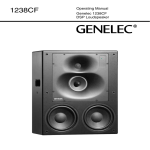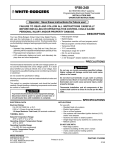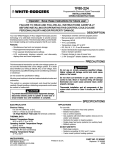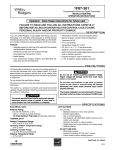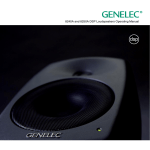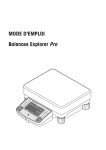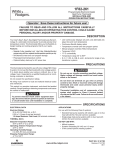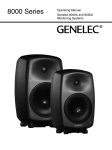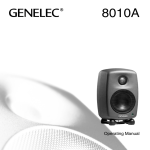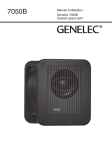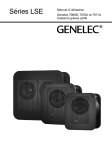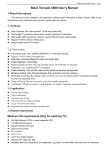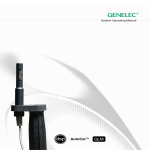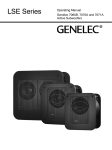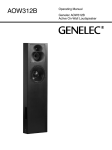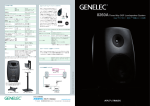Download 8260A Operating Manual
Transcript
Operating Manual 8260A, 8351A, 8250A and 8240A Introduction Congratulations and a thank-you for the purchase of this Genelec SAM system. All Genelec SAM systems are designed to integrate easily into the digital production environment. There are several ways to configure and operate SAM systems for a wide variety of high quality audio applications. The SAM monitors also have analog inputs, making them versatile and intelligent replacements for standard analog monitors. GLM NETWORK GLM NETWORK GLM NETWORK USB MICROPHONE This manual addresses the setup and use of the 8240A, 8250A, 8351A and 8260A SAM monitors in stand-alone mode without the Genelec Loudspeaker Manager GLM™ and the proprietary Genelec monitor control network. Use with the GLM™ is described in the GLM™ System Operating Manual. System Genelec 8240A, 8250A, 8351A and 8260A are designed for precise monitoring of 24 bit/192 kHz AES/EBU digital audio signal or line level analog audio signal. They are fully compatible with Genelec Loudspeaker Manager GLM™ and the proprietary Genelec monitor control network, and Genelec 7260A, 7270A and 7271A SAM Subwoofers, but can also be used independently of these. The 8240A, 8250A, 8351A and 8260A feature high SPL output, low colouration and broad bandwidth in a small enclosure size. They are suitable for a wide variety of tasks, such as near field monitoring, mobile vans, broadcast and TV control rooms, multichannel sound systems and home studios. The Minimum Diffraction Enclosure™ (MDE™), advanced Directivity Control Waveguide™ (DCW™) and Minimum Diffraction Coaxial (MDC™) technologies provide excellent frequency balance even in difficult acoustic environments. Amplifiers The amplifier unit is mounted in the rear of the monitor enclosure. The unit incorporates special circuitry for driver thermal overload protection. Variable input sensitivity allows accurate level matching to console output section. Setting Up the GLM™ Control Network Although the 8240A, 8250A, 8351A and 8260A can be used without the GLM™ software and control network, they only reach their full potential when set up and calibrated using the GLM™ software. The setup is fast and consists of the following steps: 1. 2. 3. 4. 2 Run a CAT5 (RJ45) cable from the monitor control network to the next monitor (see Figure 1). Run the final cable to control network input of the GLM Adapter device. Connect the GLM Adapter device to your computer USB connector. The cable is a part of the GLM User Kit. Place the Genelec measurement microphone at the listen- LISTENING POSITION Figure 1. GLM control network cabling 5. 6. 7. 8. ing location of the engineer, on a stand, with the microphone pointing upwards and the microphone top at the height of the engineers ear in normal working position. The microphone is a part of the GLM User Kit. Run the microphone cable to the microphone input in the GLM Adapter device. Download GLM software at the Genelec web site (www. genelec.com). Install the GLM software. Follow the GLM software instructions to measure and set up your monitors. If you plan to not use a computer for controlling the monitors, use the GLM software to write the setting into the monitors (“Store the Settings”). Using the Monitors in Stand-Alone Mode When the monitors are not connected to a Genelec monitor control network, they operate in the stand-alone mode. However, settings made with the Genelec Loudspeaker Manager software can be saved into each monitor and applied even when the network is disconnected by setting switch 1 “STORED/MANUAL CONTROL” on switch group 2 of each monitor to position “STORED.” All issues concerning use with the network are explained in detail in the System Operating Manual provided with the GLM™ Loudspeaker Manager software kit. Connections Each monitor is supplied with a mains cable, one 5 m GLM network cable and an operating manual. Before connecting up, ensure that the mains switch is off. Mains power switch Stand-alone user interface level control -8 -6 -4 -2 -10 ON OFF 1 -12 2 SWITCH 1 BASS ROLL-OFF BASS TILT 12V Remote connector (8260A only) TREBLE TILT -4 dB 160 Hz +2 dB -4 dB ON OFF dB STORED AES/EBU CH. DRIVER MUTE SYSTEM LVL. -10 -20 A B WF COAX ON OFF -2 dB -4 dB -2 dB -4 dB Mains input connector DESKTOP -6 dB -6 dB MAINS INPUT 230 V~ 50 / 60 Hz 330 W SERIAL NUMBER -2 dB 12 V REMOTE 0 SWITCH 2 -30 dB MANUAL CTRL ON + ON OFF + OFF DIGITAL IN AES/EBU SUM A AND B DIGITAL THRU AES/EBU Stand-alone user interface switch groups 1 and 2 ANALOG IN 8260A DSP TRI-AMPLIFIED MONITORING SYSTEM MAGNETICALLY SHIELDED www.genelec.com MADE IN FINLAND 292-8260T-6 GLM Control Network connectors Analog input connector Digital Thru connector Digital input connector Figure 2. Connectors and controls on the back panel of a 8260A. The 8351A is similar. 8240A and 8250A share the same layout but without the 12 V trigger voltage connector. “MAINS INPUT” Connector Connect the mains supply to this connector. “DIGITAL IN AES/EBU” Connector Use this female XLR connector for AES/EBU formatted digital audio input signals. This input is selected automatically when a valid digital audio signal is present, and overrides the analog input. Depending on the digital hardware, transmission of a 192 kHz sample rate is achieved using a double speed, single channel/ cable interface. This is called dual-wire mode. In this case one cable per channel is used and no channel selection is required. Dual-wire mode is automatically detected by the input stage. If the digital source device has a volume fader that controls the digital level, it may be advantageous to lower the level control either on the computer interface or on the monitor’s back panel controls, which in turn will force the use of more of the digital [bit] resolution in the volume control. level is +7.0 dBu RMS on models 8240A and 8250A and +22.0 dBu RMS on models 8351A and 8260A. When A/D converter input clip occurs the front panel light turns momentarily red, indicating the overload condition. “CONTROL NETWORK” Connectors Use these RJ-45 sockets to connect the monitor to the proprietary Genelec Loudspeaker Manager™ (GLM™) network only. This connector is not Ethernet LAN compatible. Do not connect to Ethernet LAN. “12 V REMOTE” Connector (8260A only) You can set up remote controlled powering up and down of the 8260A with 12 V voltage connected to this connector. The minimum current needed to actuate this function is 70 mA. Front Panel Warning Light Normally the light on the front panel of a SAM monitor is green, indicating that the monitor is in normal operational mode. The overload light (red) is activated by several events: If the digital inputs are used, all audio outputs are referenced to 0 dBFS (digital Full Scale, the largest level that may be represented in the AES/EBU signal). These monitors produce 100 dB SPL at 1 meter in free space for a digital input signal of –30 dB FS. “DIGITAL THRU AES/EBU” Connector This male XLR carries an unaltered copy of the digital signal fed into the “DIGITAL IN AES/EBU” connector. It can be used for daisy-chaining up to four monitors together. “ANALOG IN” Connector Use this connector for analog audio signals. The maximum input • exceeding the maximum input range of the analog input • the digital input level is less than 0.1 dB from the digital full scale • exceeding the output capacity of the power amplifier (clipping in the power amplifier) and thermal overload of the power amplifier or drivers (thermal protection has activated) • an error is detected in the AES/EBU audio data If a red warning light appears, turn the analog source down! If the levels are already modest and a digital signal is being used, 3 >0 ,7 m h ACOUSTIC AXIS 8240A: h=240 mm (9 7/16 in) 8250A: h=290 mm (11 1/2 in) 8351A: h=235 mm (9 1/4 in) 8260A: h=448 mm (17 5/8 in) Figure 3. The location of the acoustic axis is on the centerline of the monitor at the given height “h”. The acoustic axis of the 8351A and 8260A is located at the center of the coaxial driver. m Min 5 c Max 60 cm Figure 4. Symmetrical layout and keeping the acoustic axis clear from obstructions minimizes reflection surfaces and maintains accurate localisation because reflections are symmetrical. Avo > 60 cid m Figure 5. Recommended distances from a single wall to the front baffle of free-standing monitors. Correct (green) and not recommended (red). Figure 6. Recommended monitor positioning for 5.1 multichannel audio reproduction ensure that there are no bit errors in the AES/EBU digital audio data. able, as it minimises acoustical cancellation problems around the crossover frequency. Mounting Considerations Align the Monitors Correctly Place the monitors so that their acoustic axes are aimed towards the listening position (see Figure 3). Vertical placement is prefer4 Maintain Symmetry Check that the monitors are placed symmetrically and at an equal distance from the listening position. If possible, place the system so that the listening position is on the centerline of the room and the monitors are placed at an equal distance from the centerline (See Figure 4). Minimise Reflections Acoustic reflections from objects close to the monitors like desks, cabinets, computer monitors etc. can cause unwanted colouration and blurring of the sound image. These can be minimised by placing the monitor clear of reflective surfaces. For instance, putting the monitors on stands behind and above the mixing console usually gives a better result than placing them on the meter bridge. Symmetrical positioning of the reflective objects is also important in order to maintain a balanced soundstage (See Figure 4). Figure 7. System Level rotary control Low Frequency Cancellations In general, when a monitor’s front baffle is more than 0.3 meters (1 foot) away from the wall behind the monitor, a reflection from this wall can cause a cancellation of low frequencies and hence reduction of bass output. Distances between 1 and 2.2 meters (3-7 ft.) should be avoided (See Figure 5). As a rule of thumb, the lower the low frequency cut-off the further away the monitor must be placed from the wall in order to avoid this phenomenon. Distances to the ceiling and other walls may be shorter than the distance to the wall behind a monitor. Reflections from these surfaces may be important and should also be considered Operating Environment These monitors are designed for indoor use only. The permissable ambient temperature is 15-35 degrees Celsius (50-95°F) and permissable relative humidity between 20% and 80%. Humidity condensation on the product is not allowed during use. If the product has been stored or transported in a cool environment and then taken into a warm room, it must be allowed to warm up completely before connecting to mains power. Figure 8. Switch Group 1 can be used for securing the monitor to its base. Do not use this thread for mounting the monitor on a microphone stand which has a 3/8” UNC thread. A wide variety of ceiling and wall mounts are available through your Genelec dealer. Setting the Input Sensitivity The monitor level sensitivity functions for both analog and digital input. The sensitivity can be matched by adjusting the rotary Level control together with the System Level switches located in the switch group 2. (switches 6 and 7). The switches provide attenuation levels of -10 dB (sw. 6 ON), -20 dB (sw. 7 ON) and -30 dB (both switches ON) The combined attenuation ranges from 0 to -42 dB. Functions On Switch Group 1 (Tone Controls) Sufficient cooling for the amplifier and functioning of the reflex port must be ensured if the monitor is installed in a restricted space such as a cabinet, or integrated into a wall structure. The surroundings of the monitor must always be open to the listening room with a minimum clearance of 5 centimeters (2”) behind, above and on both sides of the monitor. The space adjacent to the monitor must either be ventilated or sufficiently large to dissipate heat so that the ambient temperature does not rise above 35 degrees Celsius (95°F). Switch group 1 (the upper switch group) comprises the tone controls that can adjust the frequency response of the system in stand-alone mode to match the acoustic environment. Mounting Options The vibration insulating Isolation Positioner/Decoupler™ (IsoPod™) table stand allows tilting of the monitor for correct alignment of the acoustic axis. The stand can be attached to three mounting points allowing vertical and symmetrical horizontal positioning. The controls are labelled “TREBLE TILT”, “BASS TILT”, “BASS ROLL-OFF” and “DESKTOP”. The factory settings for these controls are all “OFF” to give a flat anechoic response. Note that these controls have no effect when switch 1 “STORED/MANUAL CONTROL” on switch group 2 is set to “STORED” or when the monitor is connected to the Genelec monitor control network. Genelec 8240A, 8250A, 8351A and 8260A can be fitted to König & Meyer monitor mounts on two sets of M6x10 mm threaded holes on the back of the enclosure. On the base of the 8240A and 8250A enclosure is an M10x10 mm threaded hole which The use of an acoustic measurement system is recommended to analyze the effects of the adjustments, however, careful listening with suitable test recordings can also lead to good results if a test system is not available. Start adjustment by setting all switches Please note that the GLM software allows a much more versatile and precise set of controls to be used and supports the fully automatic system alignment feature, the Genelec AutoCal. Use the tone control switches on the monitor only if GLM is not available for the system calibration. 5 Monitor Mounting Position Treble Tilt Bass Tilt Bass Roll-Off Desktop Flat anechoic response None None None None Free standing in a damped room None -2 dB None None Free standing in a reverberant room None -4 dB None None Near field on a reflective surface None -2 dB None -4 dB In a corner None -4 dB -4 dB None Figure 9. Switch Group 2 AES/EBU CH Table 1. Suggested Tone Control settings for some typical monitor placement positions. to “OFF” position. Measure or listen systematically through the different combinations of settings to find the best frequency balance. See Table 1 for some typical settings. Bass Roll-Off Control Bass Roll-Off control (switches 1 and 2) attenuates its output near the cut-off frequency. Attenuation levels of -2 dB (sw. 1 ON), -4 dB (sw. 2 ON) or -6 dB (both switches ON) can be selected. Bass Tilt Control This selects the audio channel(s) available on the AES/EBU cable to be reproduced by the monitor. Turning both switches on reproduces the sum of the two channels on the AES/EBU cable. Turning both switches off mutes the monitor. When two channels are selected, 6 dB of attenuation is automatically applied to avoid overloading the monitor. If the AES/EBU cable is operated in dual-wire mode, the monitor detects this situation automatically and the channel selection switches have no effect. Driver Mute These two switches allow you to mute the treble driver (marking “TW”) and bass driver (marking “WF”) independently. This may be useful to diagnose if a transducer is faulty. The Bass Tilt control switches (swiches 3 and 4) offer three attenuation levels for the bass response below 800 Hz, usually necessary when the monitors are placed near room boundaries. The attenuation levels are -2 dB, -4 dB and -6 dB. On the 8351A and 8260A the marking “TW” is replaced with “COAX” and this switch mutes both the treble and midrange of the coaxial driver unit. Desktop Low Frequency Control These switches allow scaling down of the monitor output. The signal sent to the “Thru” output connector is not affected. The switches are additive, for example, “–30 dB” attenuation is achieved by turning on the “–10 dB” and “–20 dB” switches. The effect of these switches is combined with the effect of the rotary level adjustment control. This results in total possible attenuation of 42 dB, 30 dB by the system level switches and another 12 dB by the rotary control. The desktop low frequency control (switch 5) attenuates the bass frequencies around 160 Hz by 4 dB. This feature is designed to compensate for the boost often occurring at this frequency range when the monitor is placed upon a meter bridge, table or similar reflective surface. Treble Tilt Control Treble Tilt control (switches 6 and 7) allows adjusting the treble response above 5 kHz by +2 dB, -2 dB or -4 dB, which can be used for correcting an excessively bright or dull sounding system or to compensate for high frequency level loss if the monitor is placed behind a screen. Functions On Switch Group 2 Stored / Manual Ctrl “MANUAL CTRL” refers to controlling the monitor using the controls on the monitor’s back panel. The “STORED” refers to using settings stored inside the memory of the monitor. These settings are made using the GLM and the GLM Control Network. There is additional functionality compared to that offered by the room response correction switches on the back panel. 6 System Lvl Using the 7000 Series Analog Subwoofers with SAM Monitors Please follow the steps below to integrate an analog subwoofer into a system of SAM monitors: • Connect cables carrying analog audio to the 7000 Series analogue subwoofer first. • Connect the subwoofer outputs to the analog inputs of the SAM monitors. • Connect the GLM Control Network to the monitors. • Make a System Setup in GLM. It will consist of only monitors as this is all the network can see, so suitable Rapid Cabling Presets are “Stereo Pair (Analog)” and “5.0 Surround System (Analog)”. • Run AutoCal and review the results to check for large dips at or above 85 Hz. Move the monitors and repeat AutoCal if there is a problem. • Press “Finish”, then in the Main Page select “Menu | Store Acoustic Settings to All Online Monitors” and close GLM. • For each SAM monitor, turn it off, select “Stored” on the back of each monitor to activate the internal Acoustic Settings, and then turn it on again. • To set the phase control on the subwoofer, connect the Center channel output of the subwoofer to the monitor to be used to align phase. • Follow the instructions in the subwoofer user manual for setting phase and level. Maintenance No user serviceable parts are to be found within the monitor enclosure. Any maintenance or repair of the monitor should only be undertaken by a certified Genelec service. Guarantee Genelec 8240A, 8250A, 8351A and 8260A are supplied with a two year guarantee against manufacturing faults or defects that might alter the performance of the monitors. Refer to supplier for full sales and guarantee terms. Accessories A wide selection of accessories is available for Genelec monitors. Consult the Accessories Catalogue on www.genelec.com or your local distributor/dealer for up-to-date information. Compliance to FCC Rules This device complies with part 15 of the FCC Rules. Operation is subject to the following two conditions: • This device may not cause harmful interference, and • This device must accept any interference received, including interference that may cause undesired operation. • Increase the separation between the equipment and receiver. • Connect the equipment into an outlet on a circuit different from that to which the receiver is connected. • Consult the dealer or an experienced radio/TV technician for help. Modifications not expressly approved by the manufacturer could void the user’s authority to operate the equipment under FCC rules. Safety Considerations Although the 8240A, 8250A, 8351A and 8260A have been designed in accordance with international safety standards, to ensure safe operation and to maintain the monitor under safe operating conditions, the following warnings and precautions must be observed: • Servicing and adjustment must only be performed by a certified Genelec service. The monitor enclosure must not be opened. • Do not use this product with an unearthed mains cable or a mains connection without the protective earth contact as this may lead to personal injury. • To prevent fire or electric shock, do not expose the unit to water or moisture. • Do not place any objects filled with liquid, such as vases on the monitor or near it. • Note that the amplifier is not completely disconnected from the AC mains service unless the mains power cord is removed from the amplifier or the mains outlet. • Free flow of air behind the monitor is necessary to maintain sufficient cooling. • Do not obstruct airflow around the monitors. WARNING! These monitors are capable of producing sound pressure levels in excess of 85 dB, which may cause permanent hearing damage. Note: This equipment has been tested and found to comply with the limits for a Class B digital device, pursuant to part 15 of the FCC Rules. These limits are designed to provide reasonable protection against harmful interference in a residential installation. This equipment generates, uses and can radiate radio frequency energy and, if not installed and used in accordance with the instructions, may cause harmful interference to radio communications. However, there is no guarantee that interference will not occur in a particular installation. If this equipment does cause harmful interference to radio or television reception, which can be determined by turning the equipment off and on, the user is encouraged to try to correct the interference by one or more of the following measures: • Reorient or relocate the receiving antenna. 7 Genelec Oy 8240A d B r Genelec Oy 8240A horizontal off axis response level (dBr) vs freq (Hz) 17 Jan 06 (dBr) vs freq (Hz) 17 Jan 06 100 95 90 A 85 d B r DESKTOP LF 90 80 A 85 80 90 90 0° 15° 30° 85 80 45° 75 BASS TILT 60° 70 85 80 65 BASS ROLL-OFF TREBLE TILT 60 55 20 100 50 200 500 1k 2k 5k 50 20k 10k 20 50 100 200 500 1k 5k 2k Hz Figure 10. The curves above show the effect of the “Bass Tilt”, “Treble Tilt”, “Desktop Low Frequency” and “Bass RollOff” controls on the free field response of the 8240A. Genelec Oy 8250A d B r Figure 11. The upper curve group shows the horizontal directivity characteristics of the 8240A measured at 1 m. The lower curve shows the system’s power response. Genelec Oy 8250A (dBr) vs freq (Hz) 17 Jan 06 (dBr) vs freq (Hz) 17 Jan 06 100 95 90 A 20k 10k Hz 85 d B r DESKTOP LF 90 80 A 85 80 90 90 0° 15° 30° 85 80 75 BASS TILT 45° 60° 70 85 65 80 BASS ROLL-OFF TREBLE TILT 60 55 20 50 100 200 500 1k 2k 5k 50 20k 10k 20 50 100 200 500 1k 5k 2k Figure 12. The curves above show the effect of the “Bass Tilt”, “Treble Tilt”, “Desktop Low Frequency” and “Bass RollOff” controls on the free field response of the 8250A. Genelec Oy 8351A d B r A 20k 10k Hz Hz Figure 13. The upper curve group shows the horizontal directivity characteristics of the 8250A measured at 1 m. The lower curve shows the system’s power response. Genelec Oy 8351A dBr) vs freq (Hz) 20 Nov 2014 (dBr) vs freq (Hz) 20 Nov 2014 100 95 90 85 d B r DESKTOP LF 90 80 A 85 80 90 90 0° 15° 30° 85 80 75 BASS TILT 45° 60° 70 85 65 80 TREBLE TILT BASS ROLL-OFF 60 55 20 50 100 200 500 1k 2k 5k 20k 10k Hz Figure 14. The curves above show the effect of the “Bass Tilt”, “Treble Tilt”, “Desktop Low Frequency” and “Bass RollOff” controls on the free field response of the 8351A. 8 50 20 50 100 200 500 1k 2k 5k 20k 10k Hz Figure 15. The upper curve group shows the horizontal directivity characteristics of the 8351A measured at 1 m. The lower curve shows the system’s power response. Genelec Oy 8260A d B r A Genelec Oy 8260A (dBr) vs freq (Hz) 12 Jan 11 (dBr) vs freq (Hz) 12 Jan 11 100 95 90 85 d B r DESKTOP LF 90 80 A 85 80 90 90 0° 15° 30° 85 80 75 BASS TILT 45° 60° 70 85 65 80 TREBLE TILT BASS ROLL-OFF 60 55 50 20 50 100 200 500 1k 2k 5k 20k 10k 20 50 100 200 500 1k 2k Figure 16. The curves above show the effect of the “Bass Tilt”, “Treble Tilt”, “Desktop Low Frequency” and “Bass RollOff” controls on the free field response of the 8260A. Figure 18. 8240A horizontal directivity plot. Figure 20. 8250A horizontal directivity plot. 5k 20k 10k Hz Hz Figure 17. The upper curve group shows the horizontal directivity characteristics of the 8260A measured at 1 m. The lower curve shows the system’s power response. Figure 19. 8240A vertical directivity plot. Figure 21. 8250A vertical directivity plot. 9 Figure 22. 8351A horizontal directivity plot. Figure 23. 8351A vertical directivity plot. Figure 24 8260A horizontal directivity plot. Figure 25. 8260A vertical directivity plot. 95 d B r A Genelec Oy 8260A (dBr) vs freq (Hz) 12 Jan 11 90 85 80 75 20 50 100 200 500 1k 2k 5k 10k 20k 40k Hz Figure 26. 8260A on-axis free field response up to 40 kHz . 10 SPECIFICATIONS 8240A Drivers Bass Midrange Treble 8250A 8351A 8260A 165 mm (61/2 in) n/a 19 mm (3/4 in) metal dome 205 mm (8 in) n/a 25 mm (1 in) metal dome Dual 8 1/2 x 4 in 120 mm (5 in) Coax Al-cone 19 mm (3/4 in) Coax Al-dome 255 mm (10 in) 120 mm (5 in) Coax Al-cone 19 mm (3/4 in) Coax Al-dome Free field frequency response of system 41 Hz - 23 kHz (- 6 dB) 32 Hz - 23 kHz (- 6 dB) 32 Hz - 35 kHz (- 6 dB) 23 Hz - 40 kHz (- 6 dB) Accuracy of frequency response 48 Hz - 20 kHz (± 1.5 dB) 38 Hz - 20 kHz (± 1.5 dB) 38 Hz - 20 kHz (± 1.5 dB) 29 Hz - 20 kHz (± 1 dB) Maximum peak SPL output per pair on top of console at 1 m with music material ≥ 115 dB SPL ≥ 120 dB SPL ≥ 121 dB SPL ≥ 123 dB SPL Maximum short term sine wave SPL output at 1 m on axis in half space, averaged as specified (from 100 Hz to 3 kHz) ≥ 105 dB SPL (from 100 Hz to 3 kHz) ≥ 110 dB SPL (from 100 Hz to 3 kHz) ≥ 111 dB SPL (from 100 Hz to 3 kHz) ≥ 113 dB SPL Crossover frequency 3 kHz 1.8 kHz 470 Hz, 2.6 kHz 490 Hz, 2.6 kHz Self generated noise level in free field @ 1 m on axis (A-weighted) ≤ 10 dB ≤ 10 dB ≤ 5 dB ≤ 5 dB Input signal Analog AES/EBU (single wire and dual wire) 1 XLR female (10 kOhm input load impedance) 1 XLR female (conforms to IEC 60958-4) Output / Thru signal AES/EBU (single wire and dual wire) 1 XLR male (conforms to IEC 60958-4) Digital audio Word length Sample rate 16 - 24 bits 32 - 192 kHz Analog input level for 100 dB SPL at 1 m Maximum analog input signal -6 dBu +7 dBu +7 dBu +21 dBu Control network Type Connection proprietary GLMTM network 2 RJ45, CAT5 cables GLMTM software frequency response adjustment* Notch filters Shelving filters 2 LF and 2 HF 2 LF and 2 HF System calibration * Bass amplifier output power Midrange amplifier output power Treble amplifier output power (Long term output power is limited by driver protection circuitry) +21 dBu 4 LF and 2 HF 2 LF and 2 HF AutoCalTM, GLMTM manual, Stand-alone 90 W n/a 90 W 150 W n/a 120 W 150 W 120 W 90 W 150 W 120 W 120 W Power consumption Idle Full output 14 W 110 W 17 W 170 W 20 W 290 W 26 W 330 W Dimensions Height Width Depth Height with Iso-Pod™ 350 mm (1313/16 in) 237 mm (93/8 in) 223 mm (813/16 in) 365 mm (143/8 in) 433 mm (171/16 in) 286 mm (111/4 in) 278 mm (1015/16 in) 452 mm (1713/16 in) 433 mm (171/16 in) 286 mm (111/4 in) 278 mm (1015/16 in) 452 mm (1713/16 in) 570 mm (227/16 in) 357 mm (141/16 in) 347 mm (135/8 in) 593 mm (233/8 in) Weight 9.4 kg (20.8 lb) 14.6 kg (32 lb) 19 kg (42 lb) 27.5 kg (60.5 lb) * The notch and shelving filters adjustments, AutoCalTM and GLMTM manual system calibration features are part of the Genelec Loudspeaker Manager (GLMTM) software 11 www.genelec.com Genelec Document D0081R001b Copyright Genelec Oy 11.2014. All data subject to change without prior notice. International enquiries: In the U.S. please contact: In Sweden please contact: In China please contact: Genelec, Olvitie 5 Genelec, Inc., 7 Tech Circle Genelec Sverige Beijing Genelec Audio Co.Ltd FIN-74100, Iisalmi, Finland Natick, MA 01760, USA Ellipsvägen 10B Room 101, 1st floor Phone +358 17 83881 Phone +1 508 652 0900 P.O. Box 5521, S-141 05 Huddinge Fax +358 17 812 267 Fax +1 508 652 0909 Phone +46 8 449 5220 Email [email protected] Email [email protected] Fax +46 8 708 7071 Email [email protected] Building 71 B33 Universal Business Park No. 10 Jiuxianqiao Road Chaoyang DistrictBeijing, ChinaPhone +86 (10) 5823 2014 Post code: 100015 Email [email protected]













